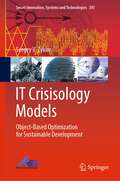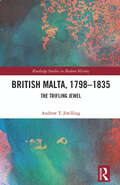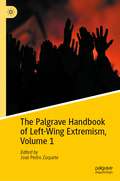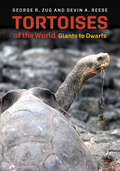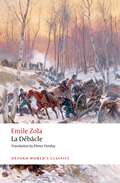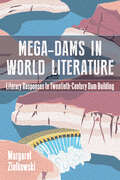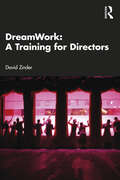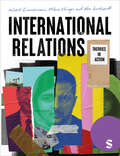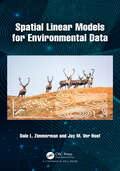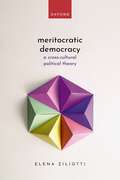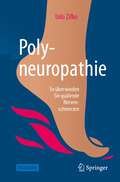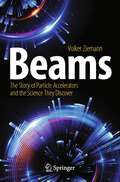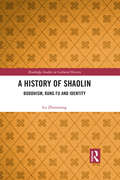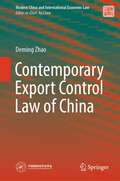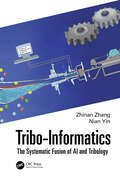- Table View
- List View
IT Crisisology Models: Object-Based Optimization for Sustainable Development (Smart Innovation, Systems and Technologies #381)
by Sergey V. ZykovThe book focuses on modeling real-world crisis management in digital product development. This includes models and methods for forecasting, responding, and agile engineering/managing for sustainable product development. This book suggests an approach that contains principles, formal models, and semi-formal practice-oriented methods, patterns and techniques to efficiently manage these crises and provide sustainable development. The book also introduces a set of principles, models, and methods for sustainable management as a blend, the components of which have been carefully selected from a few domains adjacent to digital production such as IT-intensive operation, human resource management, and knowledge engineering, to name a few. The key ingredients of this crisis management framework include smart data modeling, trade-off optimizing, agile product controlling, and knowledge transferring.
British Malta, 1798–1835: The Trifling Jewel (Routledge Studies in Modern History)
by Andrew T. ZwillingBritish Malta, 1798–1835 explores the incorporation and early administration of Malta as a British protectorate, and later as a Crown colony.Few connections existed between Great Britain and Malta before 1798, but Napoleon’s Mediterranean ambitions forged a link that remained even after the expulsion of the French. Malta’s incorporation into the British Empire encountered numerous and varied challenges: a deadly plague, diplomatic rows, economic rebuilding, continual food supply obstacles, and the unique challenge of governing a long-subjugated population. The Maltese people spent the previous 228 years ruled by an anachronistic crusading order that they were barred from joining. While most sought the protection of the British government, many also strove for more Maltese autonomy and agency. This tension helped define the first three and a half decades of British rule in Malta. Reaching beyond the traditional periodization of the Napoleonic era, this book provides a broader context of the fitful growth of the British Empire.Scholars and general readers drawn to the history of Malta, the British Mediterranean, and the expansion of the British Empire will find value in this narrative history.
British Malta, 1798–1835: The Trifling Jewel (Routledge Studies in Modern History)
by Andrew T. ZwillingBritish Malta, 1798–1835 explores the incorporation and early administration of Malta as a British protectorate, and later as a Crown colony.Few connections existed between Great Britain and Malta before 1798, but Napoleon’s Mediterranean ambitions forged a link that remained even after the expulsion of the French. Malta’s incorporation into the British Empire encountered numerous and varied challenges: a deadly plague, diplomatic rows, economic rebuilding, continual food supply obstacles, and the unique challenge of governing a long-subjugated population. The Maltese people spent the previous 228 years ruled by an anachronistic crusading order that they were barred from joining. While most sought the protection of the British government, many also strove for more Maltese autonomy and agency. This tension helped define the first three and a half decades of British rule in Malta. Reaching beyond the traditional periodization of the Napoleonic era, this book provides a broader context of the fitful growth of the British Empire.Scholars and general readers drawn to the history of Malta, the British Mediterranean, and the expansion of the British Empire will find value in this narrative history.
The Palgrave Handbook of Left-Wing Extremism, Volume 1
by José Pedro ZúqueteThis handbook provides a broad overview of left-wing extremism and its associated key issues and themes. It breaks new ground by assembling in a single volume a comparative analysis of the phenomenon that is both multidimensional and multidisciplinary. Gathering a wide range of influential scholars who have worked at length in the field of extremism studies from different perspectives, backgrounds, and geographical settings, the Palgrave Handbook of Left-Wing Extremism presents an array of thought-provoking and innovative as well as informative analyses and discussions – both historical and contemporary - about the phenomenon of left-wing extremism and of how researchers conceive of and approach it in their study. The Handbook is designed to be, for the foreseeable future, the reference work for all students, researchers, and general readers interested in achieving a comprehensive understanding of left-wing extremism in all its manifestations, subtleties, and dynamics, and bothits current and its potential directions. Chapter “Radical Left Movements in Scandinavia, 1980–2020: Straddling Militant Counterculture and Popular Movements” is available open access under a Creative Commons Attribution 4.0 International License via SpringerLink.
La D?b?cle: (reissue) (Oxford World's Classics)
by Émile Zola'My title speaks not merely of war, but also of the crumbling of a regime and the end of a world.' Émile Zola The penultimate novel of the Rougon-Macquart cycle, La Débâcle (1892) takes as its subject the dramatic events of the Franco-Prussian War and the Commune of 1870-1. During Zola's lifetime it was the bestselling of all his novels, praised by contemporaries for its epic sweep as well as for its attention to historical detail. La Débâcle seeks to explain why the Second Empire ended in a crushing military defeat and revolutionary violence. It focuses on ordinary soldiers, showing their bravery and suffering in the midst of circumstances they cannot control, and includes some of the most powerful descriptions Zola ever wrote. Zola skilfully integrates his narrative of events and the fictional lives of his characters to provide the finest account of this tragic chapter in the history of France. Often compared to War and Peace, La Débâcle has been described as a 'seminal' work for all modern depictions of war.
Mega-Dams in World Literature: Literary Responses to Twentieth-Century Dam Building
by Margaret ZiolkowskiMega-Dams in World Literature reveals the varied effects of large dams on people and their environments as expressed in literary works, focusing on the shifting attitudes toward large dams that emerged over the course of the twentieth century. Margaret Ziolkowski covers the enthusiasm for large-dam construction that took place during the mid-twentieth-century heyday of mega-dams, the increasing number of people displaced by dams, the troubling environmental effects they incur, and the types of destruction and protest to which they may be subject. Using North American, Native American, Russian, Egyptian, Indian, and Chinese novels and poems, Ziolkowski explores the supposed progress that these structures bring. The book asks how the human urge to exploit and control waterways has affected our relationships to nature and the environment and argues that the high modernism of the twentieth century, along with its preoccupation with development, casts the hydroelectric dam as a central symbol of domination over nature and the power of the nation state. Beyond examining the exultation of large dams as symbols of progress, Mega-Dams in World Literature takes a broad international and cultural approach that humanizes and personalizes the major issues associated with large dams through nuanced analyses, paying particular attention to issues engendered by high modernism and settler colonialism. Both general and specialist readers interested in human-environment relationships will enjoy this prescient book.
DreamWork: A Training for Directors
by David ZinderDreamWork: A Training for Directors provides a theoretical basis and a highly detailed, practical, step-by-step blueprint for developing a directorial concept for a play.Directing is a complex, multi-staged artistic process which, for the most part, is a collaborative work of art. The director works with designers, composers, choreographers and actors to create the performance that is eventually shown to an audience. In this process, there is one stage of the director’s work which is uniquely personal and individual: the creation of a directorial concept. This book concentrates on this crucial stage of the director’s work, offering a template for the creation of a directorial concept prior to embarking on the collaborative stage of the director’s work. The book follows the process from the choice of the text, through a series of clearly documented and structured sets of strategies with attendant examples, up to the creation of the director’s version of the original play - the adaptation - that is the starting point for the director’s dialogue with designers, composers, choreographers and actors.DreamWork: A Training for Directors is intended for directing students at universities or theatre academies, both at undergraduate and graduate levels, as well as directors at the beginning of their careers.
DreamWork: A Training for Directors
by David ZinderDreamWork: A Training for Directors provides a theoretical basis and a highly detailed, practical, step-by-step blueprint for developing a directorial concept for a play.Directing is a complex, multi-staged artistic process which, for the most part, is a collaborative work of art. The director works with designers, composers, choreographers and actors to create the performance that is eventually shown to an audience. In this process, there is one stage of the director’s work which is uniquely personal and individual: the creation of a directorial concept. This book concentrates on this crucial stage of the director’s work, offering a template for the creation of a directorial concept prior to embarking on the collaborative stage of the director’s work. The book follows the process from the choice of the text, through a series of clearly documented and structured sets of strategies with attendant examples, up to the creation of the director’s version of the original play - the adaptation - that is the starting point for the director’s dialogue with designers, composers, choreographers and actors.DreamWork: A Training for Directors is intended for directing students at universities or theatre academies, both at undergraduate and graduate levels, as well as directors at the beginning of their careers.
Sustainability Leadership: Wie Führungskräfte mitteltständischer Unternehmen Nachhaltigkeit verankern können (essentials)
by Wolfgang Zimmermann Felix Richter Andre StuerDas Buch zeigt, wie Mittelstands- und Familienunternehmen die Nachhaltigkeitswende ihres Unternehmens mit Hilfe von Sustainability Leadership meistern können. Denn zunehmende staatliche Vorgaben und die ökologische Transformation veranlassen viele Unternehmer dazu, sich aktiv mit dem Thema auseinanderzusetzen. Dabei stehen Unternehmen und Organisationen vor neuen Herausforderungen – alte Führungs- und Managementmuster passen nicht mehr. Als Führungskraft ist es nicht immer leicht, angesichts hoher Komplexität und Unsicherheit die Orientierung zu behalten und die eigene Unternehmensstrategie mit den Bedürfnissen von Mitarbeitenden und externen Stakeholdern in Einklang zu bringen. Die Autoren zeigen anhand von praxisnahen Beispielen und konkreten Werkzeugen einen ganzheitlichen und integrativen Leadershipansatz auf, wie Führungskräfte mittelständischer Unternehmen Nachhaltigkeit erfolgreich in ihrem Unternehmen verankern können. Besonders bemerkenswert: Dies kann die Geburtsstunde eines „Unternehmertum 2.0“ sein. Es basiert auf den oftmals tiefen Wurzeln des Unternehmens und neuen, innovativen Perspektiven. Interviews mit Unternehmerpersönlichkeiten vermitteln Impulse und geben Einblicke zu ihren Erfahrungen mit der Nachhaltigkeitstransformation.
International Relations: Theories in Action
by Hubert Zimmermann Milena Elsinger Alex BurkhardtThe definitive applied theory textbook that helps you make sense of global issues through theoretical concepts. Not presupposing any prior knowledge, this introduction equips you with the skills to use theories as adaptable tools to tackle complex global issues. Adopting a critical and questioning approach, you will be equipped in theory as a series of tools to be used, adapted, combined, and applied when grappling with some of the most contested issues in global politics. Theoretical perspectives are brought alive as a vital tool to understand concrete historical and contemporary examples. This indispensable text starts by examining key theories spanning constructivism and postcolonialism to realism and liberalism with a real-world perspective which prioritises empirical purchase. From here, chapters take a critical, questioning approach to tackle core problems of international politics – from armed conflict and financial markets to the climate crisis, global inequality, gender and race. This text is the ideal companion for all undergraduate and postgraduate students of global affairs. Hubert Zimmermann is Professor of International Relations at Philipps University of Marburg, Germany. Milena Elsinger is Head of the student information department at Philipps University of Marburg, Germany. Alex Burkhardt teaches at the Bundessprachenamt in Koblenz, Germany and previously taught at Philipps University Marburg, Germany.
International Relations: Theories in Action
by Hubert Zimmermann Milena Elsinger Alex BurkhardtThe definitive applied theory textbook that helps you make sense of global issues through theoretical concepts. Not presupposing any prior knowledge, this introduction equips you with the skills to use theories as adaptable tools to tackle complex global issues. Adopting a critical and questioning approach, you will be equipped in theory as a series of tools to be used, adapted, combined, and applied when grappling with some of the most contested issues in global politics. Theoretical perspectives are brought alive as a vital tool to understand concrete historical and contemporary examples. This indispensable text starts by examining key theories spanning constructivism and postcolonialism to realism and liberalism with a real-world perspective which prioritises empirical purchase. From here, chapters take a critical, questioning approach to tackle core problems of international politics – from armed conflict and financial markets to the climate crisis, global inequality, gender and race. This text is the ideal companion for all undergraduate and postgraduate students of global affairs. Hubert Zimmermann is Professor of International Relations at Philipps University of Marburg, Germany. Milena Elsinger is Head of the student information department at Philipps University of Marburg, Germany. Alex Burkhardt teaches at the Bundessprachenamt in Koblenz, Germany and previously taught at Philipps University Marburg, Germany.
Spatial Linear Models for Environmental Data (Chapman & Hall/CRC Applied Environmental Statistics)
by Dale L. Zimmerman Jay M. Ver HoefMany applied researchers equate spatial statistics with prediction or mapping, but this book naturally extends linear models, which includes regression and ANOVA as pillars of applied statistics, to achieve a more comprehensive treatment of the analysis of spatially autocorrelated data. Spatial Linear Models for Environmental Data, aimed at students and professionals with a master’s level training in statistics, presents a unique, applied, and thorough treatment of spatial linear models within a statistics framework. Two subfields, one called geostatistics and the other called areal or lattice models, are extensively covered. Zimmerman and Ver Hoef present topics clearly, using many examples and simulation studies to illustrate ideas. By mimicking their examples and R code, readers will be able to fit spatial linear models to their data and draw proper scientific conclusions. Topics covered include: Exploratory methods for spatial data including outlier detection, (semi)variograms, Moran’s I, and Geary’s c. Ordinary and generalized least squares regression methods and their application to spatial data. Suitable parametric models for the mean and covariance structure of geostatistical and areal data. Model-fitting, including inference methods for explanatory variables and likelihood-based methods for covariance parameters. Practical use of spatial linear models including prediction (kriging), spatial sampling, and spatial design of experiments for solving real world problems. All concepts are introduced in a natural order and illustrated throughout the book using four datasets. All analyses, tables, and figures are completely reproducible using open-source R code provided at a GitHub site. Exercises are given at the end of each chapter, with full solutions provided on an instructor’s FTP site supplied by the publisher.
Spatial Linear Models for Environmental Data (Chapman & Hall/CRC Applied Environmental Statistics)
by Dale L. Zimmerman Jay M. Ver HoefMany applied researchers equate spatial statistics with prediction or mapping, but this book naturally extends linear models, which includes regression and ANOVA as pillars of applied statistics, to achieve a more comprehensive treatment of the analysis of spatially autocorrelated data. Spatial Linear Models for Environmental Data, aimed at students and professionals with a master’s level training in statistics, presents a unique, applied, and thorough treatment of spatial linear models within a statistics framework. Two subfields, one called geostatistics and the other called areal or lattice models, are extensively covered. Zimmerman and Ver Hoef present topics clearly, using many examples and simulation studies to illustrate ideas. By mimicking their examples and R code, readers will be able to fit spatial linear models to their data and draw proper scientific conclusions. Topics covered include: Exploratory methods for spatial data including outlier detection, (semi)variograms, Moran’s I, and Geary’s c. Ordinary and generalized least squares regression methods and their application to spatial data. Suitable parametric models for the mean and covariance structure of geostatistical and areal data. Model-fitting, including inference methods for explanatory variables and likelihood-based methods for covariance parameters. Practical use of spatial linear models including prediction (kriging), spatial sampling, and spatial design of experiments for solving real world problems. All concepts are introduced in a natural order and illustrated throughout the book using four datasets. All analyses, tables, and figures are completely reproducible using open-source R code provided at a GitHub site. Exercises are given at the end of each chapter, with full solutions provided on an instructor’s FTP site supplied by the publisher.
Meritocratic Democracy: A Cross-Cultural Political Theory
by Elena ZiliottiMeritocratic Democracy puts into dialogue contemporary works in Western democratic theory and Confucian political theory to examine the effectiveness of democracy as a decision-making system, the role of political leaders and political parties in real-world democracies. The result is a unique cross-cultural theory of democracy, meritocratic democracy, which combines democratic principles with a system of 'partisan juries' at the party level to enhance the quality of political leaders in democracy. Ultimately, this book shows that cross-cultural dialogue is imperative to generate innovative solutions to pressing political issues and foster reciprocal corrections.
Polyneuropathie: So überwinden Sie quälende Nervenschmerzen
by Udo ZifkoKribbeln und Stechen, brennende Schmerzen, aber auch Taubheit in bestimmten Körperteilen können erste Anzeichen für eine Polyneuropathie sein. Der Ratgeber erklärt in einer dritten aktualisierten Auflage einfach und verständlich das Krankheitsbild, deutet mögliche Frühwarnsignale oder Symptome anhand von Beispielen, und zeigt den Weg zur gesicherten Diagnose mit Vorstellung der unterschiedlichen medizinischen Verfahren. Zudem werden die therapeutischen Möglichkeiten samt Selbsthilfe der Patienten beschrieben. Vorgestellt werden nicht nur ein breites Spektrum an erfolgsversprechenden Behandlungen, sondern auch eine Reihe von Selbsthilfemaßnahmen. Ergänzt wird das Buch mit praxisnahen Fallbeispielen, einem umfangreichen Serviceteil mit hilfreichen Adressen sowie Antworten auf häufige Patientenfragen. Die Neuauflage wurde erweitert mit aktuellen Informationen zu Covid-19, Long Covid und hilfreichen Bewegungsübungen. Das Buch richtet sich in erster Linie an alle Betroffene und deren Angehörigen, bietet aber auch für Allgemeinmediziner oder Vertreter anderer Gesundheitsberufen einen guten Überblick zum Krankheitsbild und den therapeutischen Ansätzen.
Beams: The Story of Particle Accelerators and the Science They Discover (Copernicus Books)
by Volker ZiemannThis book describes and explains the world of particle accelerators and the physics they study. The presentation is non-technical (E=mc2 is the only equation!) and the prose accessible. By following the co-evolution of particle accelerators and particle physics, readers will learn why the accelerators are built, how they work, and what "results" they produce. The book highlights the great ideas (e.g. synchrotron) and technological advances (superconducting magnets) that boosted the potential of accelerators and led to new discoveries, eventually resulting in the standard model of particle physics. Many concepts are illustrated with figures derived from three-dimensional models; these include theaccelerators, detectors, and particles. Background information about the main protagonists, along with pointers to further reading, e.g. from "Scientific American," are provided in endnotes.
From Coal to Hydrogen: A Long Journey of Energy Transition (Synthesis Lectures on Chemical Engineering and Biochemical Engineering)
by Qianlin ZhuangThe book tells the story of the coal gasification technology from its early days 230 years ago to the present. Before the end of WWII, gasification had been extensively used to produce both fuel gas and gaseous feedstock from coal. But things have changed when natural gas became readily available, and coal gasification received little attention, especially in recent years when the trend is to move away from fossil energy. Compared to conventional coal combustion, gasification-based processes for power production typically result in much lower emissions of pollutants. So, coal gasification technology became relevant again during the transition of energy production to cleaner sources, in an effort to fight climate change. Taking another look at gasification technology to better understand its potential benefits including carbon capture and management and use the process, seems to make sense during the challenging time of the transition of energy production. Professionalsand policy makers in the energy field will benefit from this writing.
A History of Shaolin: Buddhism, Kung Fu and Identity (Routledge Studies in Cultural History #70)
by Lu ZhouxiangShaolin Monastery at Mount Song is considered the epicentre of the Chan school of Buddhism. It is also well known for its martial arts tradition and has long been regarded as a special cultural heritage site and an important symbol of the Chinese nation. This book is the first scholarly work in English to comprehensively examine the full history of Shaolin Monastery from 496 to 2016. More importantly, it offers a clear grasp of the origins and development of Chan Buddhism through an examination of Shaolin, and highlights the role of Shaolin and Shaolin kung fu in the construction of a national identity among the Chinese people in the past two centuries.
Building Full Stack DeFi Applications: A practical guide to creating your own decentralized finance projects on blockchain
by Samuel ZhouTake your blockchain and Web3 development skills to the next level by building real-world full-stack DeFi applications with Solidity and JavaScriptKey FeaturesGain the knowledge you need to start implementing DeFi principles in practiceLearn how to build full-stack real-world DeFi products from scratch with step-by-step instructionsLeverage tools like Hardhat, Ethers.js, Node.js, React.js, Solidity, and Web3 for effective DeFi application developmentPurchase of the print or Kindle book includes a free PDF eBookBook DescriptionEnter the world of Decentralized Finance (DeFi) with Building Full Stack DeFi Applications. Understand how this blockchain-based financial technology, designed to manage crypto assets, runs independently without centralized financial institutions like banks and brokerages, eliminating the fees that banks and other financial companies charge for using their services. This book will show you how DeFi solutions are built with smart contracts running on blockchains and how they allow users to gain and earn crypto assets based on the trust of the smart contracts. This book uncovers the inner workings of DeFi by guiding you through the mathematical foundations and teaching you how to build real-world DeFi products with Solidity and JavaScript. As you progress through the chapters, you’ll learn how to implement smart contracts of liquidity pools to trade cryptocurrencies and implement staking, including farming features that allow users to earn. You’ll also find out how to create asset pools that allow users to lend and borrow cryptocurrencies and generate interest. Additionally, you’ll discover how to use Web3 libraries to build the frontend of DeFi products. By the end of this book, you’ll will be well acquainted with popular tools, libraries, and design patterns for implementing a full-stack DeFi application with Web3 and Solidity.What you will learnUnderstand the key concepts and principles of DeFi and how it worksGet to grips with smart contract development to solve complex problemsBuild your experience in designing, building, and deploying Web3 applicationsImplement liquidity pools and swapping features for seamless crypto exchangesDevelop staking and farming features for DeFi applicationsCreate smart contracts for crypto loans integrated with Web3 librariesWho this book is forIf you are a blockchain developer experienced in Web3 and Solidity development, or anyone interested in learning about blockchain and DeFi technologies, this book is for you. Product managers, executives, and other management professionals looking to start or delve into a DeFi project will also benefit from this book, as will developers and architects with basic blockchain knowledge who want to advance their skills in building full-stack DeFi products. Experience with Solidity, JavaScript, and Web3 will help you get the most out of this book.
Building Full Stack DeFi Applications: A practical guide to creating your own decentralized finance projects on blockchain
by Samuel ZhouTake your blockchain and Web3 development skills to the next level by building real-world full-stack DeFi applications with Solidity and JavaScriptKey FeaturesGain the knowledge you need to start implementing DeFi principles in practiceLearn how to build full-stack real-world DeFi products from scratch with step-by-step instructionsLeverage tools like Hardhat, Ethers.js, Node.js, React.js, Solidity, and Web3 for effective DeFi application developmentPurchase of the print or Kindle book includes a free PDF eBookBook DescriptionEnter the world of Decentralized Finance (DeFi) with Building Full Stack DeFi Applications. Understand how this blockchain-based financial technology, designed to manage crypto assets, runs independently without centralized financial institutions like banks and brokerages, eliminating the fees that banks and other financial companies charge for using their services. This book will show you how DeFi solutions are built with smart contracts running on blockchains and how they allow users to gain and earn crypto assets based on the trust of the smart contracts. This book uncovers the inner workings of DeFi by guiding you through the mathematical foundations and teaching you how to build real-world DeFi products with Solidity and JavaScript. As you progress through the chapters, you’ll learn how to implement smart contracts of liquidity pools to trade cryptocurrencies and implement staking, including farming features that allow users to earn. You’ll also find out how to create asset pools that allow users to lend and borrow cryptocurrencies and generate interest. Additionally, you’ll discover how to use Web3 libraries to build the frontend of DeFi products. By the end of this book, you’ll will be well acquainted with popular tools, libraries, and design patterns for implementing a full-stack DeFi application with Web3 and Solidity.What you will learnUnderstand the key concepts and principles of DeFi and how it worksGet to grips with smart contract development to solve complex problemsBuild your experience in designing, building, and deploying Web3 applicationsImplement liquidity pools and swapping features for seamless crypto exchangesDevelop staking and farming features for DeFi applicationsCreate smart contracts for crypto loans integrated with Web3 librariesWho this book is forIf you are a blockchain developer experienced in Web3 and Solidity development, or anyone interested in learning about blockchain and DeFi technologies, this book is for you. Product managers, executives, and other management professionals looking to start or delve into a DeFi project will also benefit from this book, as will developers and architects with basic blockchain knowledge who want to advance their skills in building full-stack DeFi products. Experience with Solidity, JavaScript, and Web3 will help you get the most out of this book.
The Household Finance Issues in China
by Sibo Zhao Dawei ZhaoThis book systematically studies and discusses pertinent issues related to household finance in China. This book not only elucidates the concept and connotation of household finance, but also extensively examines the significance and necessity of enhancing household finance and upholding household financial well-being. Drawing upon theories from economics, psychology, sociology, and behavioral finance, it conducts a quantitative analysis of family finance and its influencing factors by constructing models such as Probit model, Tobit model, and APC model to empirically test the underlying mediation mechanism. In addition, from the perspective of inclusive finance development and safeguarding the rights and interests of financial consumers, this book expounds on its profound impact on household finance.This book is a valuable reference for researchers in related fields, and it also provides some insights into residents’ and families’ awareness of financial health. Furthermore, itaids in formulating and improving consumption policies, adjusting economic structures, and preventing household financial risks. This research provides valuable guidance for enhancing family welfare and increasing property income for Chinese residents.
Contemporary Export Control Law of China (Modern China and International Economic Law)
by Deming ZhaoThis book gives practical and in-depth presentation and analysis of the issues under China export control law and economic sanctions regime. This book not only addresses issues faced by the legal entities in China, but also attends to the concerns about Chinese extra-territorial jurisdiction of China export control law and sanctions legislations, on the part of foreign companies. Finally, the author shares his experiences on how to structure export control and sanctions compliance under Chinese law on the part of both Chinese and foreign companies.
Tribo-Informatics: The Systematic Fusion of AI and Tribology
by Zhinan Zhang Nian YinThis book details how artificial intelligence and other informatic methods can be applied to the field of tribology. Using problems often found within tribological condition monitoring, behaviour prediction, system optimization and mechanism analysis, the book covers methods used such as Artificial Neural Networks (ANN).Including case studies throughout, the book offers an accessible introduction to tribological research, beginning with background on the theory behind tribo-informatics, and updates in the latest technology. It describes how to establish a tribo-informatics database, methods through which to express tribo-systems such as Artificial Neural Networks (ANN), Support Vector Machines (SVM), K-Nearest Neighbor (KNN), and Random Forest (RF), and its applications. It can be used in state monitoring, behaviour prediction and system optimization. Through case studies, practical examples of how tribo-informatics can be implemented are shown throughout various industries.This book will be of interest to students and researchers in the field of tribology, friction, wear and artificial intelligence.
Tribo-Informatics: The Systematic Fusion of AI and Tribology
by Zhinan Zhang Nian YinThis book details how artificial intelligence and other informatic methods can be applied to the field of tribology. Using problems often found within tribological condition monitoring, behaviour prediction, system optimization and mechanism analysis, the book covers methods used such as Artificial Neural Networks (ANN).Including case studies throughout, the book offers an accessible introduction to tribological research, beginning with background on the theory behind tribo-informatics, and updates in the latest technology. It describes how to establish a tribo-informatics database, methods through which to express tribo-systems such as Artificial Neural Networks (ANN), Support Vector Machines (SVM), K-Nearest Neighbor (KNN), and Random Forest (RF), and its applications. It can be used in state monitoring, behaviour prediction and system optimization. Through case studies, practical examples of how tribo-informatics can be implemented are shown throughout various industries.This book will be of interest to students and researchers in the field of tribology, friction, wear and artificial intelligence.
